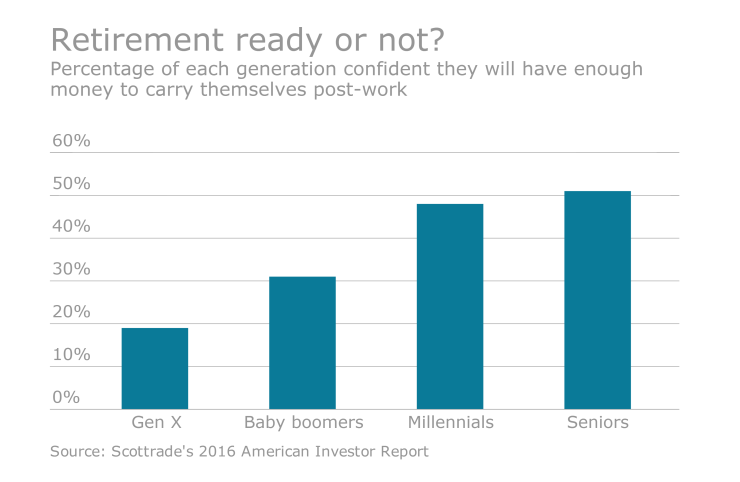People who have saved money in their workplace 401(k) plan for 15 years straight are seeing the fruits of their labor.
In Fidelity’s latest quarterly analysis, it found that the average account balance of a 15-year saver was $331,200, up from $43,900 in 2001.
“It’s great to see the progress for those that get in and stay in,” says Jeanne Thompson, senior vice president of Fidelity Workplace Investing.

As part of its research, Fidelity discovered that 55% of those 401(k) returns were from the market and 45% were due to employee and employer contributions, which “reinforces the importance of getting in the plan, contributing over time and investing in something besides cash,” she says.
Of the individuals who have saved for 15 straight years, 73% of their holdings are in equities, which include the equity portion of target-date funds. That is the same as the overall population. Where Fidelity did see a difference was in the number of long-term savers who invested 100% of their retirement funds in a target-date fund. Only 10% of those who have saved with Fidelity for 15 years held 100% of their money in TDFs vs. 44% of the entire population.
Also see: “
The biggest reason for the discrepancy is that TDFs have only become popular since the Pension Protection Act of 2006 passed. People in their 20s are defaulted into TDFs if their workplace plan has automatic enrollment, but 15 years ago, TDFs weren’t a popular option. Fifteen years ago, when they joined their workplace 401(k), they had to pick their own allocations between cash and equities.
“They got used to doing it on their own and that is what they stayed with for the most part,” Thompson says.
Of the 15-year savers, 15% hold an extreme allocation in their 401(k) plan, either 100% equities or 0% equities. For the overall population, that figure was 12%.
Inside target-date funds
Forty-four percent of account holders who utilize a TDF put 100% of their assets into it. Sixty-nine percent of account holders have some percentage of their assets in a target-date fund.
“Generally, we suggest if you hold a target-date fund, the intent is based on your age and the years until you retire. By not putting all of your assets into it, you are defeating the purpose,” Thompson says.
For example, she says that someone who invested 50% of their assets in equities and 50% of their assets in a TDF would be overweighted in equities. Or if they invested 50% in cash and 50% in a TDF, they may be underweighted in equities.
“There’s still a lot of education we need to do to educate people about what a target-date fund is and how it works,” she says. “The more we educate people, the less we will see that over time.”
Fidelity asks its 401(k) participants if they have the skill, the will or the time to manage their own retirement account. For many people, doing it themselves could be a great strategy, especially if they are interested in the markets, follow the markets, understand the different asset classes and the risk and are willing to take the time to invest in the research, she said. If people don’t have the time and don’t want to take the time or don’t feel confident in their own abilities, then going into a TDF or a managed account is a good solution.
“It depends on where you are in life and how much time you have to dedicate to it,” Thompson says.
Also see: “
Fidelity also looked at health saving accounts, which have grown in popularity. As employers move to high-deductible health care plans with HSA options, more people are saving in these plans.
Fidelity serves 193 different employers, which is a 34% increase year over year. It has 501,000 HSA participants, which is up 43% year over year.
The company classifies its HSA account holders in three different categories, HSA savers, who save 90% of their account balance in a given year; spenders, who spend 90% of their annual contributions in a year; and hybrids, who aren’t savers or spenders. They spend somewhere between 10% and 90% of their account balance in a year.
Of Fidelity’s HSA account holders, 36% are spenders, 24% are savers and 40% are hybrids, Thompson says.
The average HSA balance of a saver is $6,360. For the spender, it is $1,230; and for the hybrid, it is $3,640. The great part about health savings accounts is that the money doesn’t disappear. At the end of the year, if a participant hasn’t spent it all on qualified health care expenses, that money can be invested in mutual funds. The growth in that money can be used for health care spending long into the future.
Over six years, the average HSA saver had a balance of $22,000 in their HSA. Even spenders can accumulate money in these accounts, Thompson said, just not as much as savers.
More education is needed around these vehicles as well, she added. Three in 10 people don’t realize they can keep the money invested in their HSA. A lot believe if they don’t use it they lose it.
The average retired couple needs $260,000 to cover their out-of-pocket health care costs in retirement. An HSA is a great way to save for out-of-pocket health care expenses in retirement, she says.





